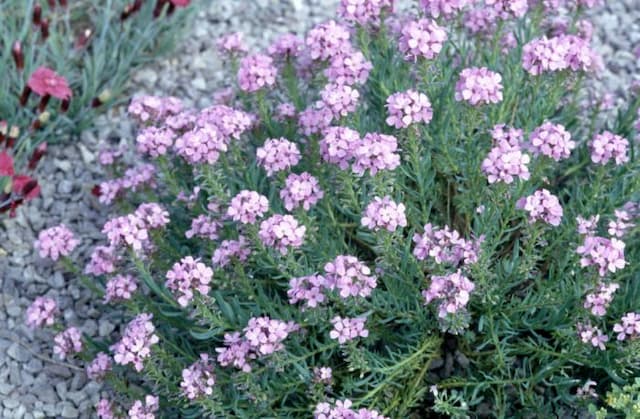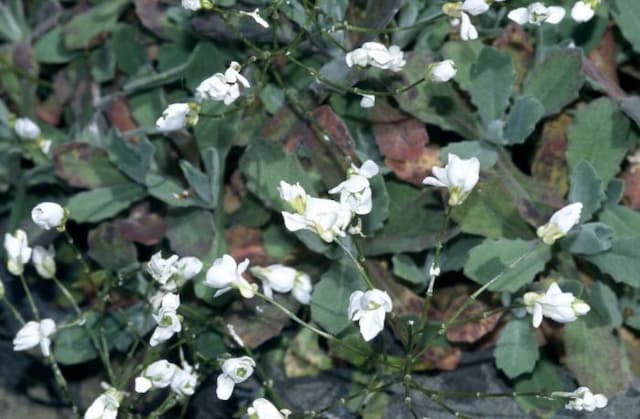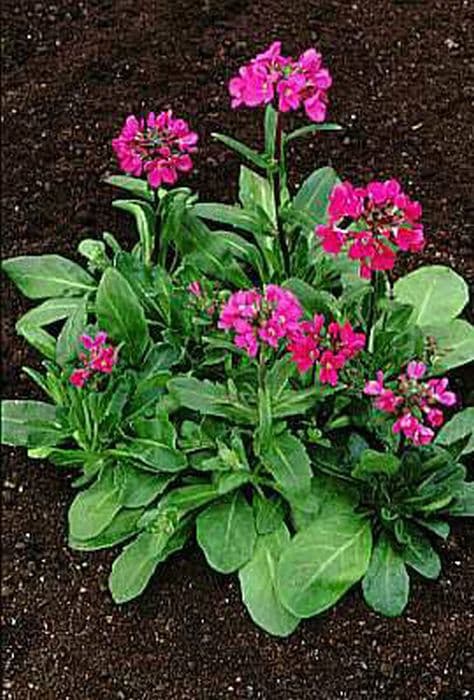Yellow Whitlowgrass Draba aizoides

ABOUT
The plant known as the yellow whitlow-grass is a perennial plant that typically exhibits a tufted or cushion-like growth habit. The leaves are small, narrow, and often have a leathery texture with smooth edges, presenting a rich green color. During its flowering period, this plant produces bright yellow flowers with four distinct petals, which are arrayed in a cross-like shape characteristic of plants within its family. The yellow of the petals is quite striking and can add a splash of color to the environments in which it grows. The plant's fruit is a long pod that contains the seeds, and it has a somewhat elongated shape. Overall, the yellow whitlow-grass has a compact, low-growing form, with foliage and flowers that are proportionately sized to create an aesthetically pleasing, small-scale alpine or rock garden plant.
About this plant
 Names
NamesFamily
Brassicaceae
Synonyms
Yellow Whitlow Grass, Mountain Draba, Aizoon Draba, Yellow Whitlowgrass, Common Whitlowgrass, Rock Whitlowgrass
Common names
Aizoon hispanicum, Alyssum aizoides, Andreoskia aizoides, Draba aizoon, Draba stylaris.
 Toxicity
ToxicityTo humans
Yellow whitlow-grass is not widely recognized as a toxic plant to humans, and there is limited information suggesting any significant toxicity upon ingestion. Generally, if a plant is not known for being poisonous, it does not typically cause severe or life-threatening symptoms. However, any plant material can potentially cause some degree of gastrointestinal discomfort if ingested, such as nausea, vomiting, or diarrhea, especially in individuals with specific sensitivities or allergies. As with any plant, it is always best to be cautious and avoid ingesting parts of plants unless they are known to be edible.
To pets
Yellow whitlow-grass does not appear on major lists of plants that are toxic to pets such as dogs and cats. There is no common knowledge of its toxicity in pets, suggesting that it is not known to cause significant harm. However, as with humans, eating non-food plants can sometimes result in mild gastrointestinal upset in pets, which might present as vomiting or diarrhea. Always monitor your pet's behaviour and health after they have consumed any plant material, and consult with a veterinarian if any concerning symptoms arise.
 Characteristics
CharacteristicsLife cycle
Perennials
Foliage type
Evergreen
Color of leaves
Green
Flower color
Yellow
Height
0.25 feet (7.62 cm)
Spread
0.5 feet (15.24 cm)
Plant type
Herb
Hardiness zones
4
Native area
Europe
Benefits
 General Benefits
General Benefits- Ornamental value: Draba aizoides, commonly known as yellow whitlow-grass, adds aesthetic appeal to gardens with its bright yellow flowers and compact growth habit.
- Drought resistance: This plant is well-suited to rock gardens and dry, poor soils due to its tolerance of drought conditions.
- Cold hardiness: Yellow whitlow-grass is capable of withstanding cold temperatures, making it suitable for alpine and subalpine gardens.
- Low maintenance: It requires minimal care once established, thus reducing the need for watering, fertilizing, and other gardening activities.
- Pollinator attraction: The flowers of Draba aizoides attract a variety of pollinators, which is beneficial for the overall health of the garden and local ecosystems.
- Erosion control: The plant's dense and mat-forming growth can help stabilize soils on slopes and prevent erosion.
- Edible parts: Some parts of the plant are edible and can be used in salads, providing a source of nutrition.
- Companion planting: Draba aizoides can be planted alongside other alpine plants to create diverse plant communities that support each other's growth.
 Medical Properties
Medical PropertiesThis plant is not used for medical purposes.
 Air-purifying Qualities
Air-purifying QualitiesThis plant is not specifically known for air purifying qualities.
 Other Uses
Other Uses- Alpine Garden Accent: Draba aizoides, commonly known as Yellow Whitlow Grass, can be used to create texture and color contrast in rock gardens or alpine garden settings due to its low-growing, cushion-like foliage and bright yellow flowers.
- Soil Erosion Control: Its ability to grow in poor soils and form dense mats makes it an excellent candidate for stabilizing soils in areas prone to erosion, such as slopes or banks.
- Garden Path Edging: The compact nature of Yellow Whitlow Grass allows it to be used as a living edge along garden paths, providing a neat, natural border that requires minimal maintenance.
- Photography Subject: Due to its vibrant flowers and early spring bloom, Draba aizoides is a popular subject for nature photographers aiming to capture the beauty of alpine flora.
- Ecological Research: Scientists may utilize this plant in studies related to alpine ecology and the impact of climate change on mountain plant communities.
- Pollinator Support: The early flowering period of Yellow Whitlow Grass provides an important nectar source for pollinators such as bees when other food sources are scarce in early spring.
- Education: This plant is sometimes used by educational institutions to teach students about plant adaptations in harsh environments, such as high altitude and cold temperatures.
- Green Roof Planting: Draba aizoides can be planted on green roofs, particularly those that replicate alpine environments, due to its drought tolerance and low maintenance requirements.
- Ground Cover: In suitable climates, it can serve as an evergreen ground cover, adding year-round interest to the landscape with minimal care.
- Artistic Inspiration: The distinct appearance of Yellow Whitlow Grass has inspired artists and craftspeople to create works of art or design patterns, especially within the themes of natural landscapes and botanical illustration.
Interesting Facts
 Feng Shui
Feng ShuiThe plant Draba aizoides is not used in Feng Shui practice.
 Zodiac Sign Compitability
Zodiac Sign CompitabilityThe plant Draba aizoides is not used in astrology practice.
 Plant Symbolism
Plant Symbolism- Resilience: Draba aizoides, commonly known as yellow whitlow-grass, often grows in rocky, alpine environments, symbolizing the ability to thrive in harsh conditions and overcome challenges.
- Persistence: The perennial nature of yellow whitlow-grass, which enables it to return year after year, is emblematic of persistence and long-term endurance.
- Adaptability: Yellow whitlow-grass's capacity to adapt to extreme environments and poor soil conditions represents adaptability and resourcefulness.
 Water
WaterYellow Whitlow Grass should be watered moderately. During the growing season, aim to water the soil when it has dried out slightly, which could roughly translate to once a week depending on the local climate and soil drainage. Approximately half a gallon of water should suffice for a small cluster of these plants, provided every 7 to 10 days. In winter, reduce watering frequency as the plant enters dormancy and the soil will retain moisture longer. Over-watering can lead to root rot, so it's important to ensure that the plant is not left sitting in water.
 Light
LightYellow Whitlow Grass thrives in full sun to partial shade conditions. The ideal spot for this plant is a location where it can receive at least four to six hours of direct sunlight daily. An east or south-facing garden spot would be beneficial to provide the morning sun, which is often ideal for plants that prefer cool yet bright conditions.
 Temperature
TemperatureYellow Whitlow Grass is known for its hardiness and can survive in a wide range of temperatures, from about -30 to 80 degrees Fahrenheit. Despite this, the ideal temperature for optimal growth is between 50 and 70 degrees Fahrenheit. Avoid placing the plant in areas where temperatures regularly exceed the upper limit, as this could stunt growth or damage the plant.
 Pruning
PruningPruning Yellow Whitlow Grass is not generally necessary as it maintains a compact size. However, if you wish to tidy up the plant or remove dead foliage, it's best to do so in the late winter or early spring before new growth begins. Prune sparingly, cutting back only the dead or damaged parts of the plant, to maintain a natural appearance and encourage healthy growth.
 Cleaning
CleaningAs needed
 Soil
SoilYellow Whitlow Grass prefers well-draining, gritty soil with a neutral to slightly alkaline pH. A mixture of sand, loam, and a small amount of compost is ideal to provide the necessary drainage and nutrients. Aim for a soil pH between 6.5 and 7.5 for optimal growth.
 Repotting
RepottingYellow Whitlow Grass does not commonly require frequent repotting as it thrives in rocky, less fertile soils. Repot every 2-3 years to refresh the soil or when the plant outgrows its current container.
 Humidity & Misting
Humidity & MistingYellow Whitlow Grass is accustomed to dry conditions and prefers low to moderate humidity levels. Avoid high humidity and ensure good air circulation to prevent any potential rot or fungal diseases.
 Suitable locations
Suitable locationsIndoor
Place in bright light and ensure pot has drainage.
Outdoor
Full sun to partial shade; well-drained soil.
 Life cycle
Life cycleDraba aizoides, commonly known as yellow whitlow-grass, begins its life cycle as a seed that germinates in early spring, typically in well-drained, rocky soils. Upon germination, it develops into a small rosette of lance-shaped leaves at ground level. This perennial plant survives through the seasons by means of its rosette, which stays evergreen even under snow cover. It enters its reproductive phase usually in the second year, when it sends up flowering stems in spring, bearing bright yellow flowers that are cross-pollinated mainly by insects. After pollination, the plant produces seed pods called siliques, which when mature, release seeds to begin a new generation. The plant can also spread vegetatively through offshoots from its rootstock, ensuring its presence in the same area for multiple years.
 Propogation
PropogationPropogation time
Spring
Draba aizoides, commonly known as Whitedraba, is typically propagated through seed sowing. The preferred time for seed propagation is in the fall after seed maturation or in early spring. Seeds are surface sown onto a well-draining soil mix and lightly pressed into the substrate. They require light for germination, so they should not be covered with soil. Instead, they can be kept moist and placed in a cold frame or an unheated greenhouse if sown in the fall. If sowing occurs in spring, seeds may be stratified for several weeks in the refrigerator at around 40 degrees Fahrenheit (4.4 degrees Celsius) before planting to simulate winter conditions and encourage germination. Once seedlings are large enough to handle, they can be transplanted individually into pots and later to their final growing positions once the risk of frost has passed.






![Aubrieta [Axcent Burgundy]](/_next/image?url=https%3A%2F%2Fplants-admin.emdemapps.com%2Fimages%2Fplants%2F%2Fimages%2F604b5b7b548d8.png&w=640&q=75)


